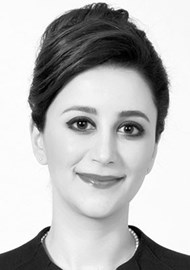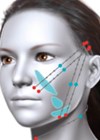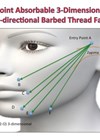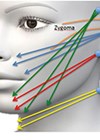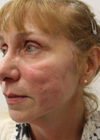"Thread lifting” is a minimally invasive outpatient procedure that is becoming increasingly popular internationally [1-3]. Threads are surgical sutures that can be utilised for facial and body contouring and rejuvenation. These sutures can be used for skin rejuvenation as bio-stimulators for “lifting” / repositioning and realignment of the soft tissues. Regardless of the aims and objectives, these treatments are known as “thread lifting” by professionals and the public.
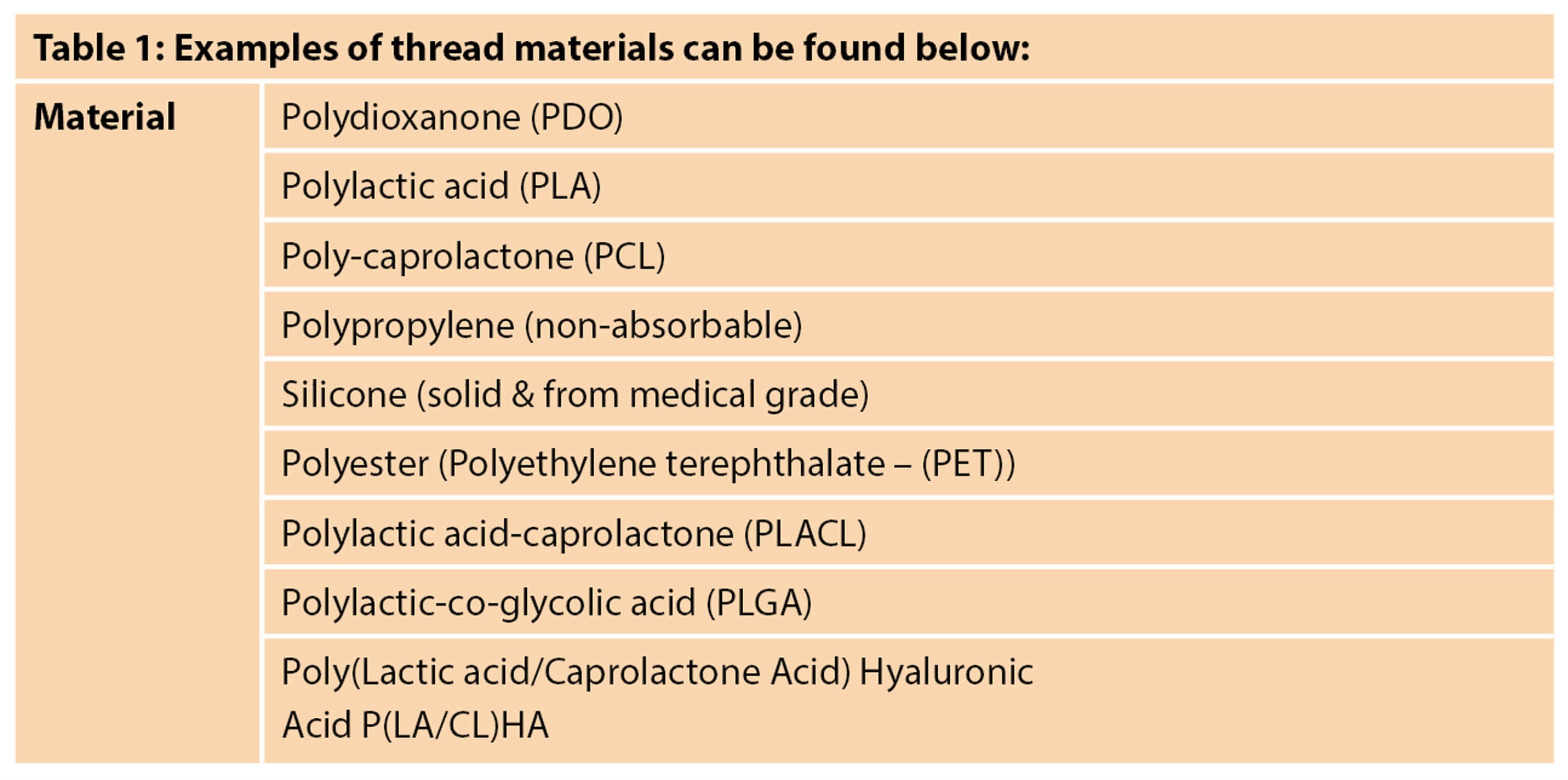
There are many thread materials available in the market with various shapes and surface characteristics (Table 1, Figure 1). Thread technology, techniques and procedure are all evolving. Improved experience and an increase in the number of peer-reviewed publications contribute to the body of evidence and help to improve safety and efficacy. Patient selection is of utmost importance and equally, patient communication and understanding of the procedure, before and aftercare, and management of patient expectations determine the fine line between patient satisfaction and dissatisfaction. Patients should undergo a comprehensive consultation and be given complete information regarding the pre-operative care, the procedure itself and what to expect, what to anticipate afterwards, the necessity of the pre-and post-treatment care, recovery time and possible need for multidisciplinary treatment. It is important to underline to the patients that this procedure is not the same as a surgical facelift and unlike the public perception not to anticipate a quick “lift” with no downtime.
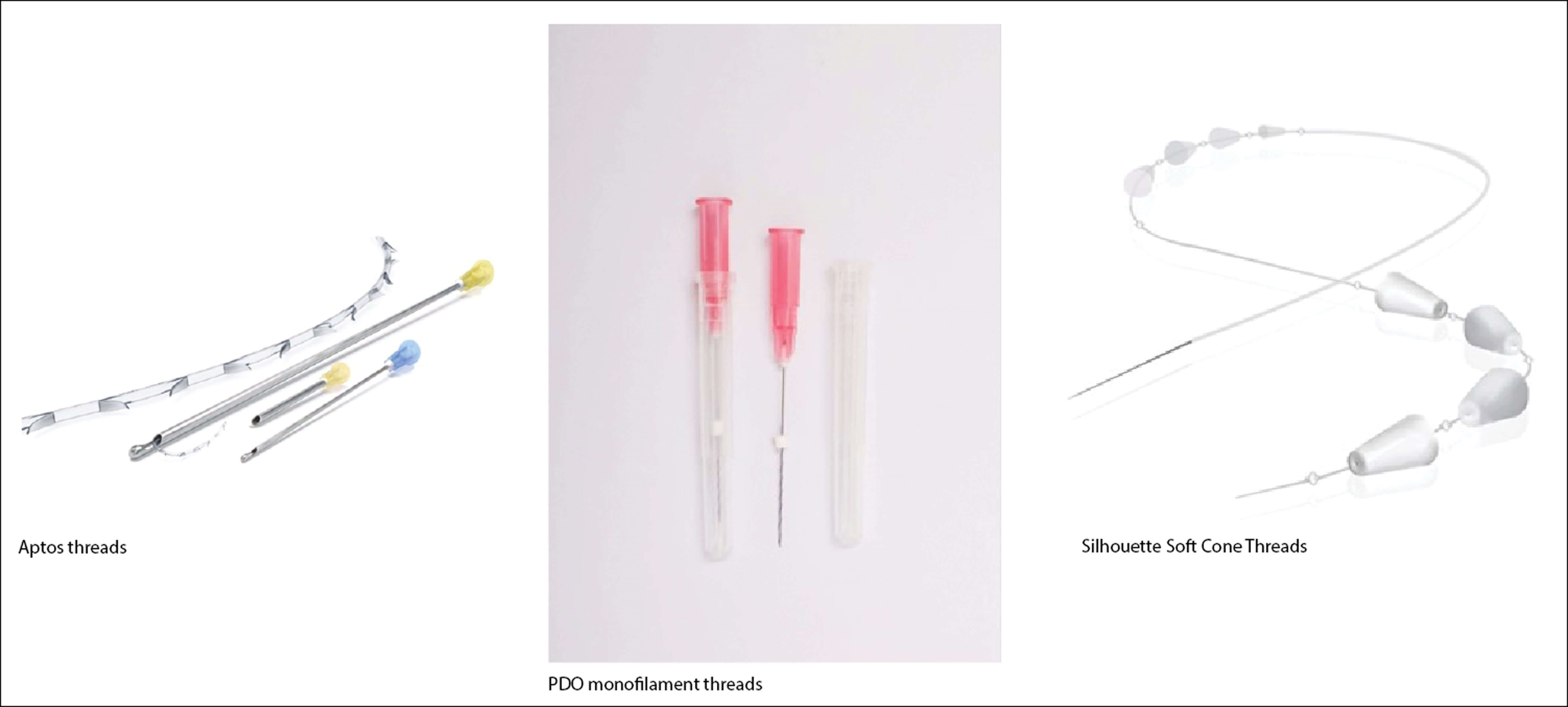
Figure 1: Example of thread types.
Thread-lifting can be provided as the sole treatment or in combination with other procedures such as facial fillers, neuromodulators, devices or surgery [3]. Threads work by re-positioning and realignment of the ptotic soft tissues and/or through bio-stimulation. The use of suspension threads in the subcutaneous layer allows the sagging tissues to be elevated in a non-surgical/minimally invasive manner [4]. Facial tissue suspension by means of threads is reported to be safe and effective with tissue repositioning which lasts up to 12 months or in some cases longer for the correction of mild to moderate ptosis of the midface and lower face [5,6].
Safe and effective use of threads for rejuvenation and recontouring requires an in-depth understanding of anatomy, thread characteristics, aseptic technique and appropriate techniques. It is important to avoid damaging the facial vasculature and nerves during facial thread lifting. In the absence of caution, the superficial temporal vein, superficial temporal artery, facial artery, and facial nerve branches are susceptible to injury. In addition, injury to the parotid gland, the duct of the parotid gland, or the muscles should be avoided by using the correct technique and thread placement [7]. Patients should be informed that the thread-lifting procedure is not a replacement for a surgical facelift and that optimal rejuvenation and recontouring require multimodal treatment over a few sessions with their respective risks and benefits and downtime.
Patients should be informed that thread placement will require pre-and aftercare. Patients usually experience localised pain, bruising and swelling post procedure and hence need to be informed and consented regarding these issues. Some downtime should be expected. Unrealistic expectations should be managed prior to the treatment and aftercare instructions need to be adhered to.
The outcome is heavily influenced by choosing the right patient and the correct indication for thread lifting treatment. Individual assessment and treatment planning should be carried out to attain the intended goal.
Thread lifting procedures can be carried out for patients in good overall health with realistic expectations of the procedure, post-procedure care, and the outcome.
The initial appointment should include a mental health screening, including psychiatric history, body dysmorphic disorder screening, and present mental state. This is for the patient’s and the practitioner’s benefit.
Clinical setting
Threads must be performed in a clinical environment under strict aseptic conditions. Thread placement requires due care and patient management; the skin should be prepped accordingly. If close to the hairline, the surrounding hair should be disinfected, the patient to wear a hair cap, and sterile drapes should be used. A case of mycobacterium massiliense granulomatous infection (rapid growing nontuberculous mycobacterium) following a thread lift procedure performed at a non-medical cosmetic beauty salon has been reported [8].
Indications and contraindications
Threads can be effectively used for those with mild to moderate signs of ageing. Patients with significant ptosis and skin laxity will see very little change. Obese patients, as well as those with particularly heavy ptotic soft tissues, will see minimal improvement. Thread lift can be done with liposuction in these patients. In cases, a surgical facelift is still the gold standard. There are definite examples of contraindications, and care should be exercised in some instances. In various situations, the clinician’s judgment should be exercised. Several examples include the following:
- Acute inflammatory processes or skin diseases in the area of treatment.
- Autoimmune and somatic diseases.
- Haemophilia (bleeding disorders)
- Susceptibility to form keloid scars.
- Allergy to the thread material or any products/medications used.
- On anticoagulants, antiaggregant.
- Mental and neurotic disorders.
- Pregnancy, breastfeeding.
- Previous non-biodegradable injection materials and implants in the area of the procedure.
- Immunologically compromising diseases.
- Atopic patients (multiple allergies).
Complications
Treatment sequalae post treatment include localised pain/discomfort, bruising and swelling, mild paresthesia/dysesthesia, linear bleeding along the thread path, asymmetry, and shallow depression of needle tracks and are all transient and self-limiting [9]. Hypercorrection is part of the treatment, and it is done to compensate for the eventual relaxation of the soft tissues post treatment [9].
Complications include persistent asymmetry, hypo- and hypercorrection, uneven contours, visible threads, thread migration or exposure, haematoma, pain, paresthesia, and damage to a vessel, nerve, or salivary gland capsule or duct. Moderate impairment of facial motions - mimetic movements, eating, speaking, and swallowing - may also occur following thread lifting but usually resolves within the first or second postoperative week [9]. With correct patient selection and technique, these can be avoided.
If approved threads with clinical studies and comprehensive research and development are used, most complications are technique related. Facial abscess from an unlicensed thread lift by a beautician has been reported [10].
Complications such as skin dimpling, asymmetry, the thread being palpable/visible, contour irregularities, or speech/expressions being affected are technique related. An infection will require treatment and, at times, removal of the threads. Inserting the threads into the correct facial layer and in-depth knowledge of anatomy will prevent complications such as nerve damage. Doppler ultrasound can detect vital structures such as the frontal branch of the superficial temporal artery in the temple area to prevent vascular complications during thread lifting [11].
Conclusion
Threads can effectively be used for rejuvenation and recontouring of the body and face. However, a successful treatment outcome has many prerequisites, including an in-depth understanding of anatomy, physiology, pharmacology, clinical and psychological assessment, facial assessment, treatment planning, clinical aseptic technique, and understanding and respect of limitations of materials and methods used. Lack of regard for the factors mentioned above and proper indications will result in relapse of ptosis, complications, and other undesirable side effects.
References
1. Sulamanidze MA, Sulamanidze GM. APTOS suture lifting methods: 10 years of experience. Clin Plast Surg 2009;36(2):281-306.
2. Sulamanidze MA, Paikidze TG, Sulamanidze GM, Neigel JM . Facial lifting with “APTOS” threads: featherlift. Otolaryngol Clin North Am 2005;38(5):1109-17.
3. Halepas S, Chen XJ, Ferneini EM. Thread-lift sutures: anatomy, technique, and review of current literature. Journal of Oral and Maxillofacial Surgery 2020;78(5):813-820.
4. Gülbitti HA, Colebunders B, Pirayesh A, et al. Thread-lift sutures: still in the lift? A systematic review of the literature. Plast Reconstr Surg 2018;141(3):341e-7e.
5. Diaspro A, Luni M, Rossini G. Thread lifting of the jawline: a pilot study for quantitative evaluation. J Cutan Aesthet Surg 2021;14(1):47-54.
6. Diaspro A, Rossini G. Thread lifting of the midface: a pilot study for quantitative evaluation. Dermatol Ther 2021;34(4):e14958.
7. Han F, Samizadeh S. Threadlift for facial contouring. In: Samizadeh S, (Ed.). Non-Surgical Rejuvenation of Asian Faces. New York, USA; Springer; 2022:349-81.
8. Shin JJ, Park JH, Lee JM, Ryu HJ., Mycobacterium massiliense infection after thread-lift insertion. Dermatol Surg 2016;42(10):1219-22.
9. Sulamanidze M, Sulamanidze G, Vozdvizhensky I, Sulamanidze C. Avoiding complications with Aptos sutures. Aesthet Surg J 2011;31(8):863-73.
10. Joethy JV, Cheah A, Ang CH. Facial abscess from unlicensed thread lift. Singapore Med J 2020;61(9):498-9.
11. Lee W, Moon HJ, Kim JS, et al. Doppler ultrasound‐guided thread lifting. J Cosmet Dermatol 2020;19(8):1921-7.
Declaration of competing interest: none declared.
COMMENTS ARE WELCOME



